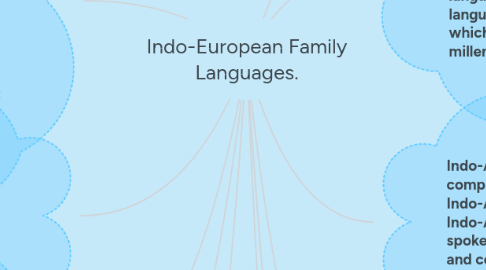Indo-European Family Languages.
von Rebeca Guzmán

1. The well-attested languages of the Indo-European family fall fairly neatly into the 10 main branches listed below; these are arranged according to the age of their oldest sizable texts.
2. Greek. despite its numerous dialects, has been a single language throughout its history. It has been spoken in Greece since at least 1600 BCE and, in all probability, since the end of the 3rd millennium BCE. The earliest texts are the Linear B tablets, some of which may date from as far back as 1400 BCE (the date is disputed) and some of which certainly date to 1200 BCE. This material, very sparse and difficult to interpret, was not identified as Greek until 1952.
3. Italic. The principal language of the Italic group is Latin, originally the speech of the city of Rome and the ancestor of the modern Romance languages: Italian, Romanian, Spanish, Portuguese, French, and so on.
4. Armenian. Armenian, like Greek, is a single language. Speakers of Armenian are recorded as being in what now constitutes eastern Turkey and Armenia as early as the 6th century BCE, but the oldest Armenian texts date from the 5th century CE.
5. Celtic. Celtic languages were spoken in the last centuries before the Common Era (also called the Christian Era) over a wide area of Europe, from Spain and Britain to the Balkans, with one group (the Galatians) even in Asia Minor.
6. Albanian. The language of the present-day republic of Albania, is known from the 15th century CE. It presumably continues one of the very poorly attested ancient Indo-European languages of the Balkan Peninsula, but which one is not clear.
7. Germanic. In the middle of the 1st millennium BCE, Germanic tribes lived in southern Scandinavia and northern Germany. Their expansions and migrations from the 2nd century BCE onward are largely recorded in history.
8. Balto Slavic. The grouping of Baltic and Slavic into a single branch is somewhat controversial, but the exclusively shared features outweigh the divergences. At the beginning of the Common Era, Baltic and Slavic tribes occupied a large area of eastern Europe, east of the Germanic tribes and north of the Iranians, including much of present-day Poland and the states of Belarus, Ukraine, and westernmost Russia.
9. Tocharian. The Tocharian languages, now extinct, were spoken in the Tarim Basin (in present-day northwestern China) during the 1st millennium CE. Two distinct languages are known, labeled A (East Tocharian, or Turfanian) and B (West Tocharian, or Kuchean).
10. Anatolian. Now extinct, Anatolian languages were spoken during the 1st and 2nd millennia BCE in what is presently Asian Turkey and northern Syria. By far the best-known Anatolian language is Hittite, the official language of the Hittite empire, which flourished in the 2nd millennium.
11. Indo-Aranian. Indo-Iranian comprises two main subbranches, Indo-Aryan (Indic) and Iranian. Indo-Aryan languages have been spoken in what is now northern and central India and Pakistan since before 1000 BCE.


